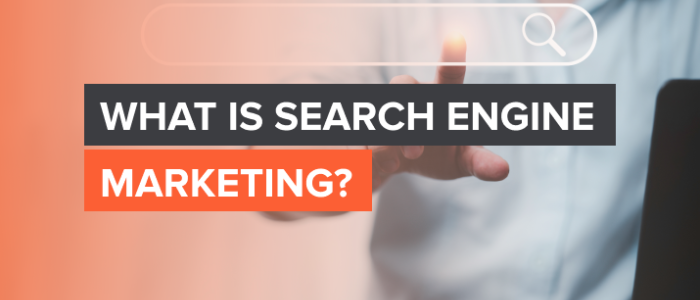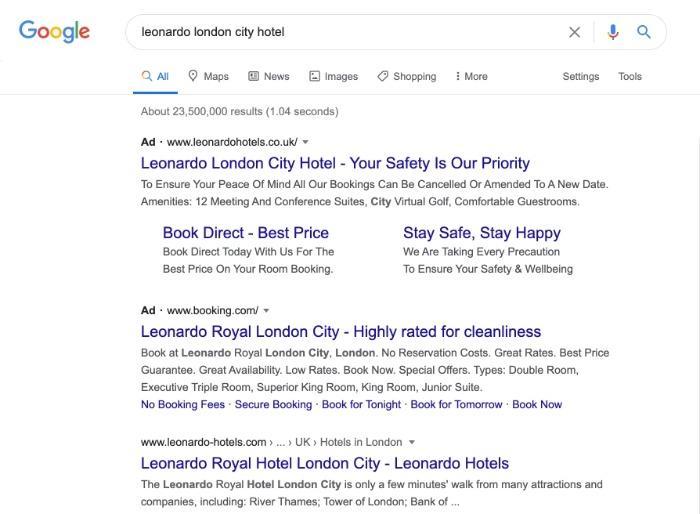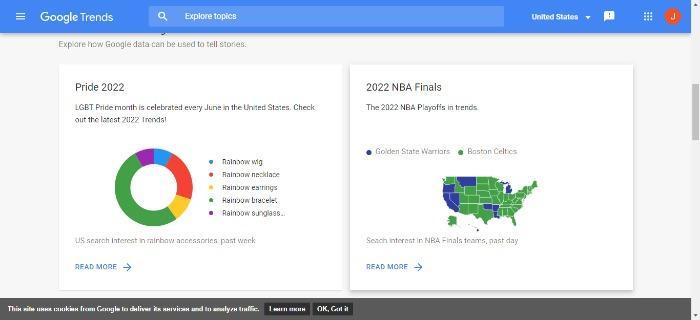
What Is Search Engine Marketing?
What if I told you there’s a simple way to get noticed online that anyone can use?
Have you guessed what I’m talking about yet? It’s search engine marketing.
Although it’s sometimes confused with SEO, SEM marketing relates to your paid advertising efforts like Google Ads to improve the visibility of a website or product in the search engine results pages (SERPs) and helps establish brand recognition.
Search engine marketing takes the form of responsive, Google shopping, and service ads. You also see them as text ads, like this one:

However, it’s not quite as simple as paying for an ad and hoping for the best. As an advertiser, you need to have:
- A targeted strategy behind your paid advertising campaigns
- An understanding of your competitors
- A method for carefully selecting your keywords and phrases that appear in the ads
- An effective ad campaign
Since SEM marketing is open to everyone, provided their budget permits, vast numbers of agencies use this method to get results, and they’re happy to spend large amounts of money on it. Research from the State of PPC 2022 shows that agencies surveyed pay anything from $5,000 to over $20 million monthly on PPC.
The Fundamentals of Search Engine Marketing
Just like most other forms of online promotion, SEM marketing works best when you get the fundamentals right. Where do you start, and what do you need to consider? Hold on while I cover some of the basics:
- Do your research: Your ads are only as effective as your keyword research. Without this, you can’t target your ideal customers, and you’ve little chance of converting click-throughs into customers. There are numerous free and paid-for tools you can use for finding keywords. Start with Ubersuggest for strong keyword ideas. Alternatively, you can use Google Trends to find out what’s hot.

- Set a budget: Next, you want to think about the cost. It’s easy to burn through your PPC budget if you’re not careful. However, by focusing on your Quality Score and concentrating on keyword relevance, you can keep your costs down.
- Use keywords in other online content. For consistency, make sure you use relevant keywords on your website or landing page, too.
- Target your ads: Who are your ideal customers and how can you reach them? Consider aspects like locations, timezones, devices they use, where you’re likely to find them online, etc.
Why Is Search Engine Marketing Important?
There are many reasons why SEM marketing is at the heart of many companies’ marketing plans. Its key advantages include:
- It’s a great way to target potential customers who are already interested in your offer. You can specify the keywords you want your ads to target, so you only pay for clicks from people who are actually interested in what you’re selling.
- SEM allows you to track your results closely. By using targeted keywords and analyzing the data collected by sites like Google Analytics, you can see which ads are working best and adjust your budget accordingly.
- SEM marketing can help improve your website’s visibility and ranking on search engines quickly,This means more people see your website when they search for relevant terms.
Overall, search engine marketing is an effective and affordable way to reach more potential customers and grow your business.
However, perhaps you still need another reason to consider using this technique? Okay, so here it is:
Research shows there are at least 8.5 billion Google searches every day. If you want prospects to find you, SEM marketing gives you a pretty good chance of getting your ad in front of your ideal customers.
How Does SEM Complement SEO?
SEM and SEO are two different aspects of online marketing, but they can work together to create a successful campaign.
SEO is the process of optimizing a website for search engines. This includes improving the website’s content, structure, and on-page elements like titles, metatags, and anchor text. Obviously, keywords and competitor research are a huge part of your digital marketing campaigns, too.
While SEO helps businesses attract more organic traffic from search engines, you’re playing the long game. Often, SEO takes time, and you can’t expect to get results overnight. However, if you’re patient and using an effective strategy, you should start to see an increase in traffic.
In contrast, SEM can provide immediate visibility for new or updated content, as well as by targeting specific keywords and phrases that you aren’t targeting through organic SEO. Additionally, you can use SEM to remarket/retarget previous website visitors, increasing the chances of them returning to your site and converting.
Search engine marketing can be a powerful tool in your online marketing arsenal and should be considered an important part of any comprehensive online marketing strategy.
You can get a better idea of how the two compare in terms of conversions, etc., from the image below:

However, neither approach works well without a detailed plan, so ensure you get the basics right first.
How Does an Ad Auction Work?
You now know that search engine marketing involves paying for PPC ads through Google Ads, or similar. However, what about pricing?
Basically, an ad auction determines the price you pay for your advert. Let me explain some more.
In its simplest form, an ad auction is a process where advertisers compete against each other to place ads on web pages like Facebook or Google. The auction system determines how much each advertiser pays for their ad placement or the ‘ad rank’. Then, the search engine or site displays the highest bidders ad.
To participate in an ad auction, you must first create an account with a search engine marketing (SEM) provider, like Google, Bing. or Facebook.
With your account set up, you must create a campaign and add funds to your account. The next step is to create your ad, which involves writing text that describes your product/service, integrating keywords, and creating graphics.
Below is Google’s step-by-step guide explaining how it displays ads:
- When a person searches, Google’s Ad system identifies ads with keywords matching the search.
- Google’s system ignores ineligible ads. For example, if an ad targets a different location than the ones you’ve selected.
- Next, Google displays ads with a high enough Ad Rank. This depends on ad quality, search context, bid price, budget, and keyword competition, along with other factors.
Google also states that highly relevant keywords and ads may still secure a higher position even if others have higher bids.
Additionally, Google explains that each auction may have different results, and your ad position may fluctuate or may not show at all.
How To Build A Strong Search Engine Marketing Strategy
There are many different components of a successful search engine marketing strategy, but following these key steps gives you a strong foundation you can adapt as you go:
1. First, identify your target audience, their demographics, and your goals. Who is your ideal customer? What do you want to achieve with your marketing campaign? Knowing this helps you determine which keywords to target and create relevant ads.
2. Next, create a budget and set realistic expectations. Although it’s often worthwhile, a search engine marketing campaign can cost you a lot of money. Make sure you have the resources to support it long-term.
3. Use keyword research to determine relevant keywords for your business. This targets your ads and optimizes your website for search engines. It’s a great idea to analyze your competitors’ keywords and the backlinks they’re creating, too.
4. Now, craft your adverts. Ensure you focus your adverts on your customers, highlight the features and benefits of your product/service, and include your chosen keywords.
5. Think beyond your ads. Your search engine marketing efforts don’t end with adverts. Ensure your ads lead to a high-quality, aesthetically pleasing website, which is consistent with your ads in tone and appearance.
6. Finally, track your SEM marketing efforts. This helps you can measure their effectiveness and make necessary adjustments. Use web analytics tools to track website visitors, clicks, conversions, and other key metrics.
Now let’s get into some of the finer points.
Best Practices for SEM
What are some best practices for search engine marketing? Begin by thinking of it as part of your entire marketing/business growth strategy, not as a separate entity. Think about how it fits in with everything else you’re doing and how SEM fits in overall. Then:
- Align your SEM with your business goals: For example, do you want to increase click-throughs? Enhance conversions? Secure long-term customers? Once you know that, you can create your strategy around it.
- Narrow down your audience: For instance, if you want customers in a certain location, geo-targeting is the way to go. By narrowing your ads’ targeting to a specific area, you can ensure that you’re hitting your desired demographic with your marketing efforts. This can be especially useful for small businesses focusing on a particular region or city.
- Consider keyword intent: What is keyword intent? In a nutshell, it’s why someone is typing a particular keyword into a search engine.
Let me elaborate on this for a moment:
When it comes to SEM marketing, understanding keyword intent is core to your results. Without it, you’ve got less chance of succeeding because you don’t know what your customer wants.
I know what you’re thinking, ‘How can I determine keyword intent?’ It’s OK, you don’t need to become a mind reader! Just do the following:
- Look at the search results. What type of content is ranking for your chosen keyword? Is it a blog post, a product page, or something else entirely?
- Analyze which keywords people use to discover your website; any good analytics program should tell you this. What words are they typing into Google? What do these searches tell you? Are they looking for information, or are they ready to buy? Understanding keyword intent enables you to choose the right keywords to target and create content that meets the needs of your audience.
- Finally, I can’t say this enough: track your search engine marketing results. Use analytics to determine which ads and keywords are most effective, and make changes to ensure that you’re reaching your target audience.
In addition, keep in mind that a successful SEM campaign requires ongoing optimization.
Common SEM Marketing Mistakes
Unfortunately, many businesses make common mistakes that can hurt their campaign results. I’m going to start with some of the most frequent search engine marketing errors. Here goes:
1. Not targeting the right keywords. One of the biggest mistakes businesses make is not targeting the right keywords. They may choose keywords that are too competitive or that don’t accurately reflect their business. Another common error is failing to consider keyword intent or the funnel stage.
2. Focusing on short-term results. Another common mistake is focusing on short-term results instead of long-term goals. SEM should be part of your entire marketing strategy, not a standalone tactic.
3. Creating poor quality, dull content. Badly written adverts that don’t engage potential customers damage your brand and may affect your ad rank.
4. Writing conflicting/confusing content. For example, your ad content may conflict with your website or landing page content. For instance, there may be conflicting tones or styles between the two. Keep to one style, tone, and language to create cohesiveness and enhance your branding.
5. Failing to A/B test. Could a change in one element boost your click-throughs or conversions? You don’t know unless you test.
Then there’s the more technical side. Not using all the tools available to you makes your job harder than it needs to be.
It’s vital that you understand that you don’t have to guess at it! Google has tools to help bolster and target your campaigns, such as conversion tracking, keyword tools, exact match modifiers, and campaign experiments for control group testing.
For instance, the Google Ads Editor is an important tool for search engine marketing (SEM). The editor helps manage ads, keywords, and campaigns. It’s easy to use and makes managing ads a breeze. The editor also makes it easy to make changes and track results.
Finally, don’t overlook your quality score. I’ve already mentioned it briefly, but it’s worth repeating. Ignore this, and it doesn’t matter how good your product/service is.
Quality score is important for two reasons: it helps you save money on advertising costs, and it helps you get better ad placement. If you’re looking to improve your Google Ads campaigns, focus on improving your quality score.
There are a few things you can do to improve it:
- Make sure you’re using relevant keywords in your ads
- Write interesting and engaging ads
- Target the right audience
FAQs
Search engine marketing (SEM) and search engine optimization (SEO) are two different things, but they both work to improve your site’s visibility on search engines.
SEM coves paid search advertising, such as Google Ads, while SEO is the practice of optimizing your website content and structure so that your site appears higher in search engine results pages (SERPs).
The most obvious benefits are increased visibility, which can equal more leads, conversions, and customers.
Search engine marketing is a great way to reach out to new customers and attract them to your business. When you use search engine marketing techniques, you can target potential customers who are already interested in what you have to offer.
Conclusion
SEM marketing is a great way to improve your website’s visibility and increase traffic. It can help you reach your target audience more effectively and boost your online presence. By using SEM, you can grow your business and generate more leads.
It works well alongside other proven techniques, like SEO. However, it delivers some of the benefits that a search engine optimization campaign can’t, such as quicker visibility.
Whether you go with search engine marketing or SEO, it’s imperative that you have a strong strategy, avoid common mistakes, and track your results.
Does SEM marketing work well for you?


